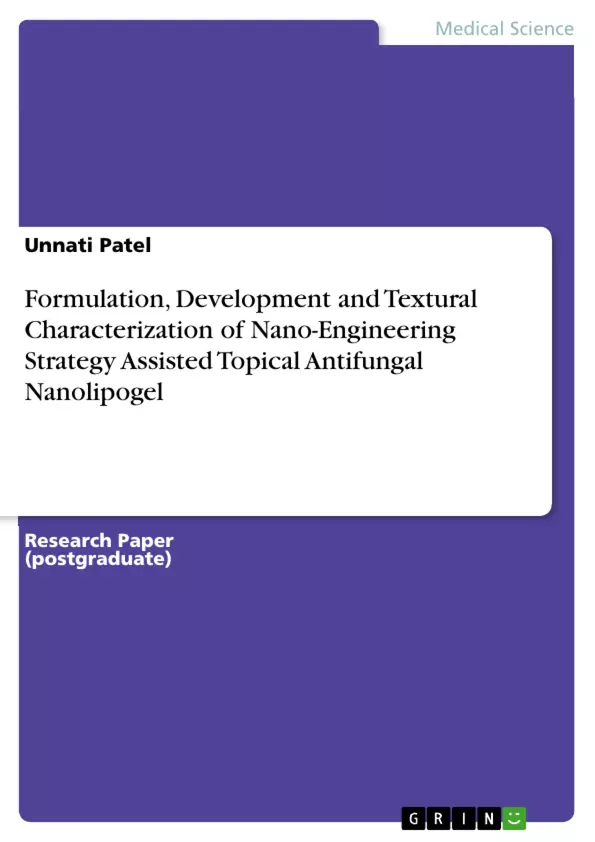The aim of the present research work was to formulate, develop and characterize topical antifungal nanolipogel using hundred-times-washed cow ghee base known as shatadhautaghrita. It is used as a permeation enhancer to increase the permeation rate of fluconazole. Nine formulations of nanolipogel were prepared using different concentrations of carbopol and shatadhautaghrita. The optimized batch of nanolipogel (formulation F7) was evaluated for pH, percentage yield, drug content, extrudability, rheology. The consistency, spreadability and formation of nanosize particles were assessed through texture profile analysis and zetasizer.
Fluconazole (FLZ) is an antifungal agent used mainly in topical formulations to treat various skin disorders such as oropharyngeal candidiasis, cryptoccocal meningitis and cutaneous dermatophyte infections. FLZ is a synthetic triazole derivative that acts as an antifungal. FLZ preferentially inhibits fungal cytochrome P-450 sterol C-14 alpha-demethylation.
Shatadhautaghrita(SDG) is used as a natural permeation enhancer in topical products. It is prepared by washing cow ghee 100 times with water.shatadhautaghrita is (shata = one hundred, dhauta = washed) clarified butter fat that has been washed 100 times. The use of shatadhautaghrita in managing conditions such as burns, chicken pox, scars, wounds, herpes, leprosy and other skin diseases and as a vehicle for drugs for external application are mentioned in traditional texts. The characteristic odour and granular, oily consistency of cow ghee are not present in shatadhautaghrita, and so it is a homogeneous, smooth, non-oily product that is easier to apply. The neutral pH of shatadhautaghrita compared with the acidic pH value of ghee makes shatadhautaghrita beneficial by preventing skin irritation. The reduced particle size of shatadhautaghrita makes the product non-granular, non-sticky and homogeneous, which makes it easy to apply it on the skin and may result in an increased rate of absorption through the skin. Washing results in a homogeneous oil-in-water emulsion with better consistency and viscosity, which makes it suitable for use in topical applications.
Inhaltsverzeichnis (Table of Contents)
- Abstract
- Introduction
- Materials And Methods
- Preparation of ShataDhauta Ghrita
- Preparation of Nanolipogel
- Results And Discussion
- Conclusion
Zielsetzung und Themenschwerpunkte (Objectives and Key Themes)
This research aims to formulate, develop, and characterize a topical antifungal nanolipogel using shatadhautaghrita, a hundred-times-washed cow ghee base, as a permeation enhancer to increase the permeation rate of fluconazole. The study evaluates the physical properties, drug release, and antifungal activity of the developed nanolipogel formulations.
- Development of a topical antifungal nanolipogel using shatadhautaghrita as a permeation enhancer.
- Evaluation of the physical characteristics and textural properties of the nanolipogel formulations.
- Assessment of the in-vitro drug release and ex-vivo permeation profiles of fluconazole from the nanolipogel.
- Investigation of the antifungal activity of the nanolipogel against Candida albicans.
- Comparison of the nanolipogel's performance with a commercial antifungal gel.
Zusammenfassung der Kapitel (Chapter Summaries)
- Abstract: This section provides a concise overview of the research, highlighting the formulation, development, and characterization of the nanolipogel. The aim is to improve the permeation rate of fluconazole using shatadhautaghrita and evaluate the antifungal activity of the resulting formulation.
- Introduction: The introduction discusses fluconazole as a topical antifungal agent and its limitations, particularly its low permeability. The use of shatadhautaghrita as a natural permeation enhancer is highlighted, emphasizing its potential for enhancing drug delivery and its unique properties compared to cow ghee. This section sets the context for the research by explaining the rationale behind using shatadhautaghrita in the formulation of the nanolipogel.
- Materials And Methods: The materials and methods section details the preparation of shatadhautaghrita, outlining the specific steps involved in the 100-time washing process. The preparation of the nanolipogel is described, outlining the ingredients, formulation methods, and the nine different formulations prepared with varying concentrations of carbopol and shatadhautaghrita. This section provides a detailed account of the experimental procedures used in the study.
Schlüsselwörter (Keywords)
The research focuses on topical nanolipogel formulation, utilizing shatadhautaghrita as a permeation enhancer for fluconazole. The study explores the impact of this innovative approach on drug release, permeation rate, and antifungal activity. The key terms encompassing this work are topical nanolipogel, shatadhautaghrita, fluconazole, permeation, and particle size.
- Citar trabajo
- Unnati Patel (Autor), 2019, Formulation, Development and Textural Characterization of Nano-Engineering Strategy Assisted Topical Antifungal Nanolipogel, Múnich, GRIN Verlag, https://www.grin.com/document/1417665



